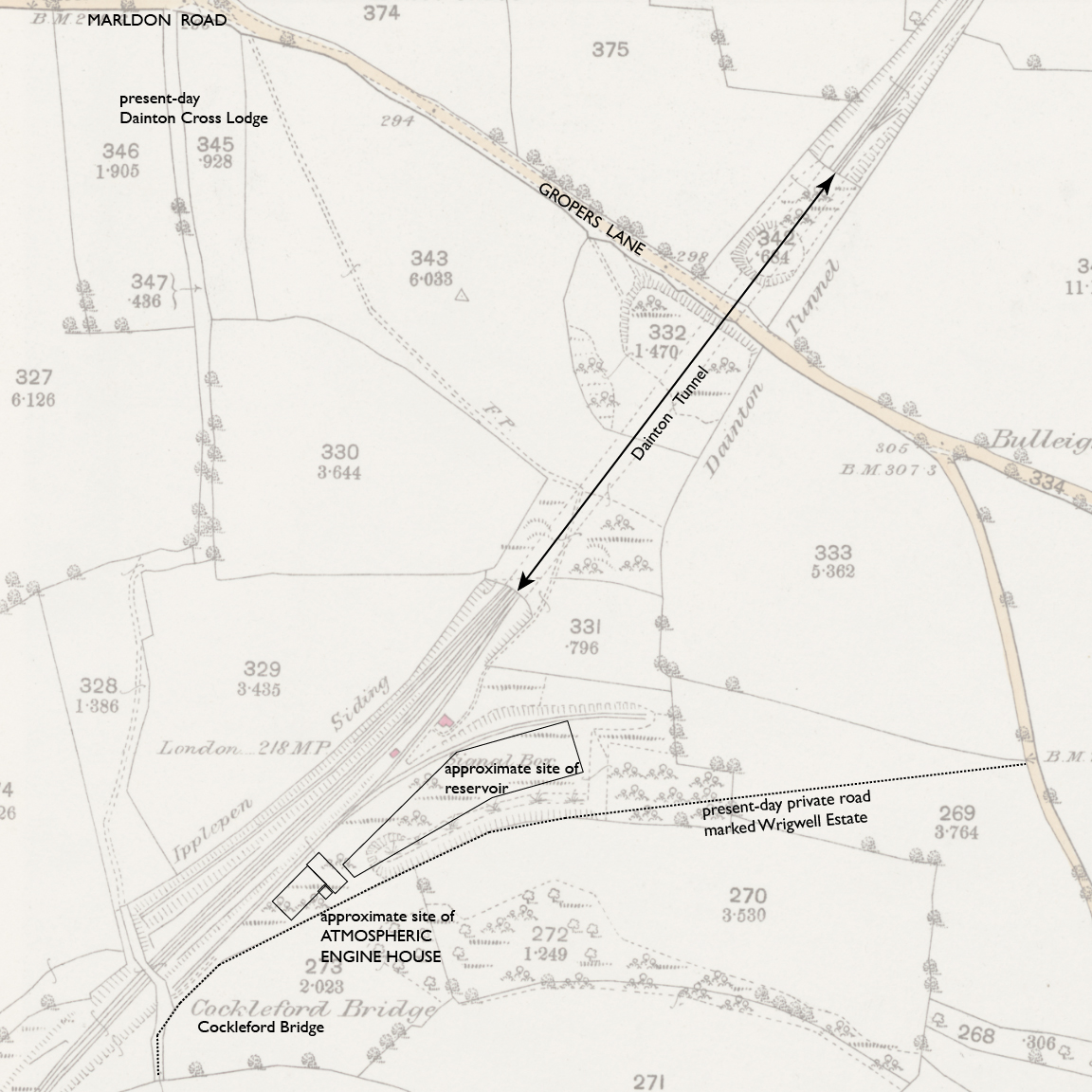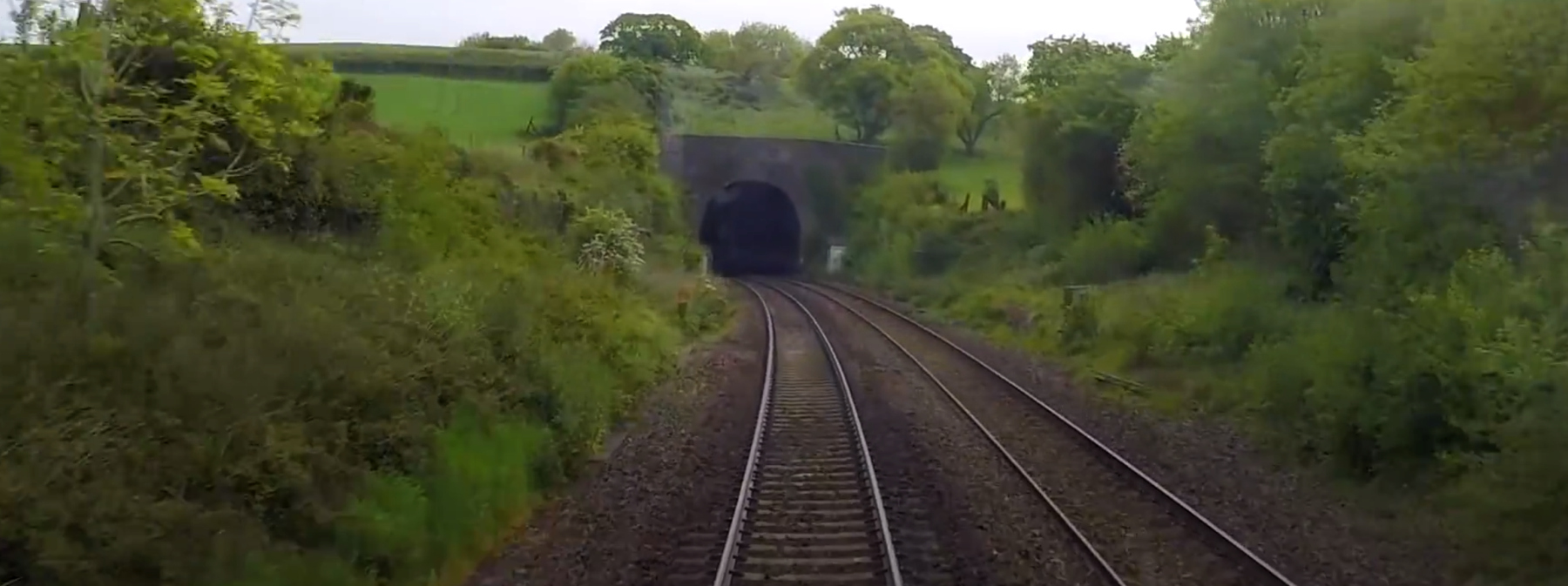South Devon Railway
Dainton
In which Joe thinks twice about which is the most obscure engine house on any atmospheric railway.
Explorations: 25 June 2018 and 21 October 2019.
Journey: Paddington to Totnes.
-
OFTEN CITED REFERENCES
- Paul Garnsworthy, editor, Brunel's Atmospheric Railway, The Broad Gauge Society, 2013.
- Peter Kay, Exeter–Newton Abbot: a Railway History, Platform 5, 1991, and excerpts in Garnsworthy.
- Howard Clayton, The Atmospheric Railways, the author, 1966.
- Charles Hadfield, Atmospheric Railways, David and Charles, 1967.
- G.A. Sekon, A History of the Great Western Railway, Digby, Long, 1895.
The ninth engine house on the South Devon Railway was in the Devon hills near a village called Dainton. Construction began about May 1847, and it was complete by about July 1848 with the installation of engines purchased from the London and Croydon Railway, where they would have powered the Epsom branch. As late as the August meeting of the Board there were still some in attendance who wanted to see Dainton put into use, but it never happened. It was the last engine house to be completed.

— Dainton, Ordnance Survey 25-inch, 1890. CC BY-NC-SA 4.0 courtesy National Library of Scotland.
Annotations by Joseph Brennan.
The site just west of Dainton Tunnel is today deep within private property that is not much more built up now than it was over a century ago. I have marked where a private road runs to it. You can get near here from Ipplepen, the nearest populated place with so much as a bus stop, by a road with the amazing name of Gropers Lane, which crosses over the tunnel. The OS map shows a public footpath running from Dainton Cross to a point over the tunnel and then to the engine house site, but it's not on Devon's current map of footpaths. The view from Cockleford Bridge is probably very good but it too seems to be far from a public right of way.

— William Dawson, Dainton engine house, via Brunel's Atmospheric Railway.
William Dawson gives us a wonderful view of the site in 1848. Like the building at Newton, this one is of grey stone with none of the red of the seaside engine houses. In front is a wooden trestle for coal wagons, maintaining a level unlike the descending main line. Once again we have to wonder how the wagons come off the main track, by switch or turnplate, but it was definitely at the highest point, near the tunnel, and so presumably the gap in the atmospheric pipe was there. The arrangement of the building is not clear, but the farthest part appears to be the engine house proper and the nearer two parts the boiler house. There were three boilers here, not just two, and possibly the third one was a late change and accounts for the separate peaked roof. I don't know what the workmen are doing over there on the right.
It's nearly impossible to see anything from the train. The driver's eye view below gives you an idea of the territory. The tunnel was enlarged later for two tracks.

— "The Last Day of the High Speed Train, Plymouth to London", screen cap at 39:15, from Great Western Railway, 18 May 2019.
The location was an important one. It is at the top of Dainton Bank, rated today as the third steepest incline on a British railway, reaching about 2.8% on the east side. The tunnel played a part in reducing the height the railway needed to reach. Brunel at times proposed using atmospheric propulsion only on the steep banks, as an alternative to bank engines. I wonder how that would have worked. Would the piston carriage have been part of the train to Plymouth, adding its push whenever it entered atmospheric pipe? To enable it, Dainton engine house would have needed to exhaust the larger 22-inch pipe and do it with enough power to pull not only a train but the bulk of a locomotive, which would at times be slipping and not helping.
The following text from 1870, while maintaining a cheerfully proper attitude, makes a point of the civil engineering on the railway.
The less rapid puffing of the locomotive reminds us that we are ascending the steep incline leading to the Dainton Tunnel. We now ascend, by sharp curves, through a picturesque and rocky pass, called Stony Coombe, formerly tenanted, if we may believe the local traditions, by an "uncanny sprite," whose history has formed the subject of a legendary tale in the pages of a local magazine, called "The Western Miscellany." But matter-of-fact Science has probably now dislodged the ghost, and we look for him in vain from the windows of our carriage. The incline we are now ascending is one of the steepest in the kingdom, the rise varying from 1 in 40 to 1 in 50 ; and the difficulty of the ascent is increased by the sharpness of the curves, many of which are of only a quarter-of-a-mile radius.— The Route Book of Devon, for Rail and Road. A Guide for the Stranger & Tourist. With Maps and Plans. A New Edition. Exeter: Henry Besley, 1870.
South Devon Railway Profile
The profile below of the entire South Devon Railway was published in 1899. The usual vertical exaggeration makes very clear the steep banks on both sides of Dainton and one side of Rattery and Hemerdon. It's peculiar that where the grades are steepest and the pipe the largest, the engine houses are about 4 miles apart instead of the 3-mile spacing used as far as Newton Abbot. No atmospheric work was done beyond Rattery, but Brunel proposed locations at Wrangaton, Ivy Bridge, and Hemerdon. Based on spacing Colebrook (Plympton) would be next, and from the profile it is obvious that one more at Mutley would be required.

— "Section of South Devon Railway", in Frederick Bramwell, "The South Devon Railway", Proceedings, Institution of Mechanical Engineers, 1899, parts 3 and 4.
Annotations by Joseph Brennan.